What can explain the American disinterest in soccer, the favorite sport of the rest of the world? I’m sure I don’t know.
Shmegley McSchmoop
A children’s classic in the making. Just needs an illustrator.
“Shmegley McSchmoop, please bring me some soup!”
Cried the customer to the headwaiter.
“I need something hot, so what have you got?
We can talk about main courses later.”
“Today, sir, the soup is just cold gloppy goop,”
Said Shmegley McSchmoop with some sorrow.
“But the chef says that we will be serving split-pea
If you come back at this time tomorrow.”
A little of Andy lives on in me
In 1978, it was rare ever to encounter a computer, much less someone who had one at home. The “personal computer revolution” was only about a year old, with Apple, Commodore, and Radio Shack all introducing their first consumer models in 1977.
Of the people who did have computers at home, surely only a small fraction were so generous with them as to allow their sons’ twelve-year-old friends to spend afterschool hour after hour, day after day, month after month sitting at them, tapping in and trying out dumb little programs; and an even smaller fraction were also seasoned programming experts with the desire, ability, and patience to impart some of that expertise to receptive but very green ears.
This weekend I, one of those twelve-year-old friends in 1978, mourn the passing of Andy Kane, one of those generous and patient computer owners. Andy was one of the many reasons I was lucky to befriend his son Chuck in the seventh grade. He was a living example of the ability to make a career out of writing software and he contributed significantly to nurturing the then-embryonic skills that today support me and my family. My condolences to his; I will always be grateful.
You can’t go home again, unless you are just in the nick of time
1999: Andrea and I (finally) get married at Sunset Point, a beautiful circle of palm trees atop a grassy knoll overlooking the Seven Seas Lagoon and, in the distance, the Magic Kingdom, at the Polynesian Resort in Walt Disney World.

The years that follow: we start a family, hoping always to return to that magical spot.
2013: We (finally) return to WDW and Sunset Point, this time with the fruits of our union.

A few months later (as I learned just this morning via a Google Follow Your World update), Sunset Point looked like this:
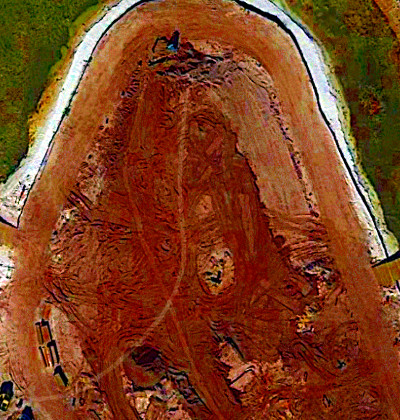
Gone forever, to make way for the construction of new villas over the lagoon, and as part of a general revamp of the resort, probably in anticipation of Disney’s upcoming Polynesian-themed film Moana.
Walt Disney himself endorsed the continual reimagining of his parks, and no doubt the Polynesian will be as magical after these changes as it was before. But that circle of palm trees was my one favorite place in the entire world. Goodbye Sunset Point! Thank heavens we made it back to you just in time.

Exciting coincidence!
California’s license-plate scheme is
digit-letter-letter-letter-digit-digit-digit
We can consider this as a number written with one base-10 digit followed by three base-26 digits (where A is 0, B is 1, C is 2, etc.) followed by three more base-10 digits. It’s easy to convert such a sequence to a pure base-10 number. For instance, 0AAA000 is 0. 0AAA001 is 1. 0AAA002 is 2. And so on up through 0AAA999, which is 999, and then to 0AAB000, which is 1,000. 0AAC000 is 2,000. 0AAZ000 is 25,000. 0AAZ999 is 25,999, and 0ABA000 is 26,000. And so on.
Here is a short Python function that does the conversion:
def plate_to_number(sequence):
result = 0
for character in sequence:
if character.isdigit():
result = result * 10 + int(character)
elif character.isalpha():
character = character.lower()
result = result * 26 + (ord(character) - ord('a'))
return result
My first license plate on moving to California in 1992 was 2ZZZ923, whose number value is 52,727,923. Now here’s the exciting coincidence: the number value of my current license plate, from 2007, is almost exactly double that (to within an error of 0.014%)!
Well, it’s exciting to nerds.
Movies that move me
I get asked about my favorite movies less often than you might think, so when the question does come up I’ve been in the habit of shrugging it off with a simple, “There’s too many to choose from.” Recently however I was inspired to give the question a proper go and I came up not with a single favorite (because there’s too many to choose from), but with this impressionistic list of movies I would watch at the slightest encouragement no matter how recently I’d seen it, which strikes me as the closest category to “favorite movie” that I can actually answer. Undoubtedly this list is incomplete, and possibly there are films here that I will take off the list some day, but without further ado, and in no particular order (indeed, in a deliberately randomized order) here they are:
Benji; The Matrix; The Incredibles; Die Hard; Zero Effect; Singin’ in the Rain; Memento; Jaws; Risky Business; Silverado; Casablanca; Safety Not Guaranteed; Repo Man; Waitress; The Karate Kid (1984); Being John Malkovich; The Parallax View; Body Heat; Tangled; Eternal Sunshine of the Spotless Mind; The Adventures of Robin Hood (1938); The Natural; The Guns of Navarone; A Hard Day’s Night; Apollo 13; Field of Dreams; My Favorite Year; To Live and Die in L.A.; Pulp Fiction; Koyaanisqatsi; Ferris Bueller’s Day Off; Roman Holiday; Groundhog Day; Broadway Danny Rose; The Great Train Robbery (1979); Brick; The Rocketeer; It’s a Wonderful Life; The Sting; Mary Poppins; Ocean’s Eleven (2001); 1776; Scott Pilgrim vs. the World; Shakespeare In Love; The Silence of the Lambs; Get Shorty; Time After Time; Kiss Kiss Bang Bang; Pirates of the Caribbean: The Curse of the Black Pearl; Goldfinger; Jacob’s Ladder; The Game; The Iron Giant; Hopscotch; North by Northwest; The Godfather; The Goodbye Girl; Pocketful of Miracles; Secretary; Amadeus; Swingers; Airplane!; Sleepless In Seattle; Trading Places; Animal House; The Brothers Bloom; What’s Up Doc?; Crimson Tide; Aliens; Bedazzled (1968); After Hours; Fight Club; Silver Linings Playbook; Almost Famous; Enchanted; The Shawshank Redemption
A handful of movies, like Raiders of the Lost Ark, Star Trek II: The Wrath of Khan, and The Adventures of Buckaroo Banzai Across the 8th Dimension, are in their own special pantheon. And then there’s Star Wars. My relationship to Star Wars is… complicated.
The nature of reality, part 3b: The speed of light
This is a followup to The nature of reality, part 3: Gravity specifics.
The speed of light, we know, is the universe’s speed limit. Nothing can move faster than that through space.
Are we missing the point? Maybe it’s not so much that that’s the top speed through space; maybe that’s the only speed through spacetime, and everything is moving at it — you, me, light, trains, turtles, mountains, everything, always. “Slower” things are moving at the speed of light more in the time direction of spacetime than in the space direction. “Faster” things are moving at the speed of light more in the space direction of spacetime than in the time direction. What we call “acceleration” is (I speculate) nothing other than changing the direction of your constant motion, more timeward or more spaceward. Non-spaceward motion (i.e., standing still) is what we experience as the ordinary passage of time.
If this is anything like right, then it supplies an intuitive foundation for thinking about all kinds of weird mysteries: why the speed of light is a constant in all reference frames (the paradox that got Einstein thinking about relativity in the first place); what’s special about acceleration; and time dilation and the physical basis of the Lorentz transformation.
The nature of reality, part 3: Gravity specifics
Reality is maddening. A deep understanding of it is elusive. If you think you understand its nature, you’re not trying hard enough.
Every now and then, however, I get a flash of insight that seems to put the nature of reality just nearly within my grasp. The feeling is brief and tantalizing, like trying to recall the details of a dream as they evaporate on waking. But it’s thrilling.
My latest one came while pondering the odd fact that there is no discernible difference between gravity and the acceleration due to motion.
When you’re sitting in a parked car, there is a force pressing your butt down into the seat. That’s gravity acting on your mass. (I’ll refrain from making comments about the mass of your butt.) When you peel out of that parking space and go from zero to sixty in 6.2 seconds, there is another force pressing your back against the seat. That’s acceleration. Science says that if you didn’t already know which force was acting on you, and the only clue you had was how it felt (not how it looks out the window, not the roar of the engine, not that you remember the Earth being beneath your feet when you got into the car, etc.), you couldn’t tell whether you were sitting still in a gravity field or accelerating through space, or some combination of both.
This turns out to be useful for sending humans on long interplanetary journeys in the future. If we invent a propulsion system that can sustain enough power continuously, then the spaceship can accelerate at 1g halfway to its destination, then turn around and decelerate (which is just accelerating in the other direction) at 1g the rest of the way. The humans on board will avoid the many health hazards of prolonged weightlessness; they’ll experience “gravity” holding them to the spaceship’s floors.
But what accounts for the fact that gravity and acceleration are the same thing? When you’re accelerating, your velocity is changing from moment to moment. And your velocity is nothing more than a measure of how your position changes from moment to moment. If your velocity is constant, you experience no acceleration. That is, you can be changing your position, but as long as it changes at a steady rate, you’re not accelerating. On the other hand, as soon as there is a change in the rate at which your position changes, the force due to acceleration appears.
- Velocity: rate of change of position
- Acceleration: rate of change of velocity
You can have lots of velocity and still have zero acceleration. If you plot your position over time on a graph, anything that’s a straight line means your velocity is constant and you’re not accelerating. To get acceleration, the graph needs to curve. (Any curve will do, but if the acceleration happens to be constant, then the curve is a parabola.)
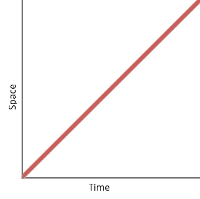
Unchanging velocity; no acceleration, no force.
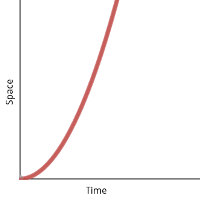
Velocity changing at a constant rate; produces a parabolic curve and a steady force.
Wrap your head around this
Here’s another recent insight that might help you to understand the idea of spacetime: The Big Bang happened in this very spot 13.8 billion years ago, and it’s also happening right now, 13.8 billion light-years away in every direction.
When you’re standing still on the ground and experiencing the pull of the Earth’s gravity, what’s changing to make that feel like acceleration? Not your position (with respect to the Earth). Not the rate of change of your position. But time is passing, and thanks to Dr. Einstein we know that space and time are mysteriously bundled together into something called spacetime. So even if you’re not moving through space, you’re always moving through spacetime.
But as I pointed out above, it’s not enough to be moving to experience acceleration. The rate at which you’re moving must itself be changing. When you’re standing still on the Earth, you’re moving through spacetime, yes; but the rate at which you’re moving through spacetime stays the same. So again: what’s changing that can give rise to a force like acceleration?
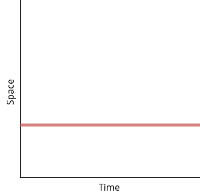
Standing still in space…
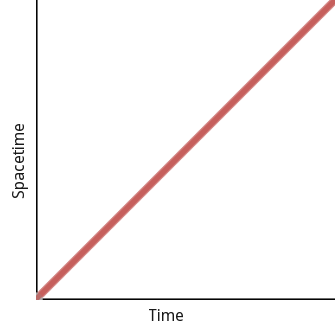
…is still moving through spacetime.
Well, hang on. We know (also from Einstein) that the presence of a large mass like the Earth causes spacetime to curve — whatever that means. So maybe it’s wrong to draw our spacetime axis as a straight line.
Suppose spacetime happens to curve just like this:
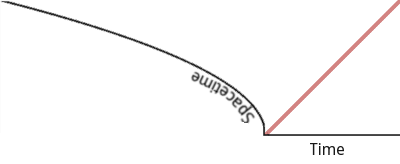
Standing still in curved spacetime.
Straightening the axis again forces the plot into a curve. (In fact, in this [manufactured] case it forces it into the shape of our old friend the parabola.)

Standing still in curved spacetime.
So. I’ve managed to convince myself that just standing still in a region of curved spacetime can look exactly like accelerating in a region of flat spacetime. Spacetime itself remains a difficult idea to internalize, to say nothing of it being curved, and even if I’ve managed to make one graph look like another in a hand-wavy way, still none of it makes any intuitive sense.
But I observe that moving at a constant velocity requires no energy. You need energy to change your velocity — i.e., to accelerate. And you need mass to curve spacetime. And as we know (thank you once again, Dr. Einstein), energy and mass are the same. Somehow it’s all down to the interactions between space, time, and energy. But what are they?
See what I mean? I can almost feel what real understanding would be like. It’s maddening.
[Update: followup thoughts added here.]
Fatal attraction flaw
When I was young, I was smart, and I knew it. And when I thought about how I would attract women, it was always going to be with my big brain. Some of my peers sported fashionable clothing. Some could dance. Some were athletic. Some played musical instruments. Some could make small talk. I disdained them all as beneath me. I attended to basic grooming and hygiene, of course, but gave little further thought to my appearance. If a woman couldn’t appreciate me for my wit and my wisdom, it was her loss, not mine.



These were actual conscious thoughts I remember having. (In fact I was rationalizing what was, at root, simple laziness.) At the very same time I was having them, whose pictures did I have on my bedroom wall? Supermodels. Christie Brinkley. Paulina Porizkova. Cindy Crawford. Which classmates did I have crushes on? The prettiest ones, the same ones all the other boys liked.
This hypocritical disparity never struck me, I’m chagrined to admit, until just a few years ago, around the time I started thinking about advising my sons on how to attract women, when the time comes. Happily they’ve got a nice head start compared to where I was at their age. They’re athletic and musical. They’re starting to show some fashion sense. Crucially, they’re smart, smarter than I was: smart enough to understand that smarts aren’t everything.
Have you herd?
[Cross-posted at facebook.com/bob.glickstein/posts/10151865534302377.]
Suppose there’s a disease that has a 50% chance of infecting you if you come into contact with it. Now suppose you come into contact with 10 people in one day. On average, 5 of them will be carrying the disease. Your odds of avoiding the disease are 50%×50%×50%×50%×50%, which is about 3%. In other words, you have a 97% chance of contracting it.
Now suppose you – and only you – get vaccinated. Let’s say it reduces your odds of infection, when exposed, from 50% down to 10%. Since no one else is vaccinated, when you come into contact with 10 people, it’s still the case that 5 are infected. Your odds of avoiding the disease are now 90%×90%×90%×90%×90%, or 59%. There is a 41% chance you’ll get sick. That’s a big improvement compared to 97%, but we can do a lot better.
Now suppose everyone gets vaccinated. Of the 10 people you come into contact with, on average only 1 will be infected. Your odds of getting sick are now only 10%.
That is the power of herd immunity.
![[click to embiggen]](https://www.emphatic.com/bobg/soccer-baseball-400.gif)